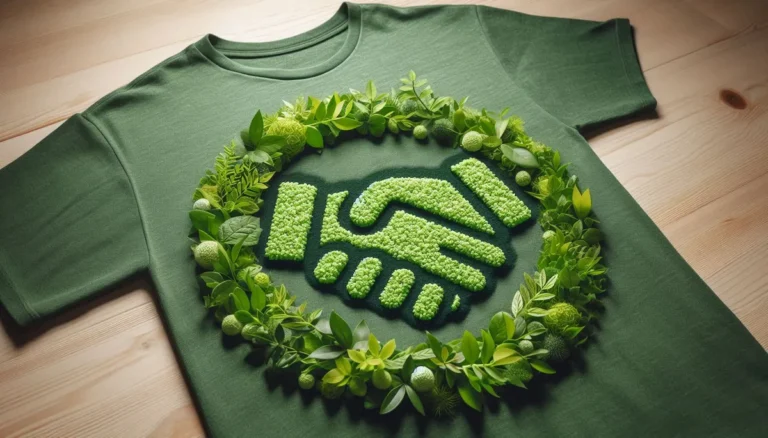Fashion is more than what you wear. It tells about who you are, how you feel, and your personality. Every day, every dress you wear tells a different story. But do you know the real cost of the clothes you wear? Behind every fashion trend and stylish design lies a harsh truth.
Fast fashion uses up a lot of natural resources. The fashion industry causes 10% of all carbon emissions around the world. It also produces 20% of the world’s wastewater, which pollutes rivers and harms animals. Even worse, about 85% of clothes go into landfills every year.
So, if you care about your health, your planet, and the well-being of others, it’s time to rethink how you dress. This is where sustainable fashion comes in.
What is Sustainable Fashion?
Sustainable fashion is a movement that aims to protect the planet and people. It is about making environmentally friendly choices regarding the clothes you wear. It uses sustainable options like organic cotton, reused fabrics, and natural dyes.
Beyond materials, sustainable fashion ensures that garment workers are treated fairly. It guarantees they work in safe conditions and receive fair wages.
Sustainable fashion encourages investing in good-quality clothes. These are made to last long and won’t go out of fashion quickly, so you don’t have to buy new clothes every time.
In short, sustainable fashion helps reduce environmental damage and supports fair labor practices. Apart from this, there are many more good reasons to shift towards sustainable clothing. Let’s explore why sustainable fashion is important and how it helps the environment.
Why Is Sustainable Fashion Important?
1. Reduces Environmental Impact
The fashion industry has a serious impact on the environment. It is responsible for about 10% of global carbon emissions. It uses a lot of water. For example, it takes about 2700 liters of water to make one T-shirt, which is a huge amount.
That’s where sustainable fashion comes in. It prioritizes eco-friendly materials like organic cotton, hemp, and recycled fabrics. These choices reduce water usage, minimize the use of harmful chemicals, and generate less waste.
2. Minimize Waste Through Recycling
Fast fashion pressures us to buy clothes to follow the ongoing fashion trends. As a result, millions of tons of clothing go to landfills every year.
Sustainable fashion offers a better path. It focuses on recycling and reusing clothes instead of throwing them away, and even encourages donating clothes we no longer need. Today, many creative brands and designers are designing clothes from recycled fabrics. They also transform old clothing into stylish, new pieces.
By actively supporting sustainability in fashion, you can create a system where clothes are not wasted.
3. Promotes Fair and Ethical Labor Practices
The hidden cost of cheap clothing often lies in the exploitation of workers. Many fashion brands produce clothing where workers are paid less and work in unsafe conditions.
In contrast, sustainable fashion brands ensure that the people involved in the production are paid well and work in a safe and respectful environment. Choosing sustainable fashion supports workers and creates an ethical fashion industry.
4. Supports Local Communities
Sustainable fashion often creates a strong connection between brands and local communities. Many sustainable brands directly work with local businesses and skilled artisans. This approach supports local economies and keeps traditional craftsmanship alive.
When you buy from these brands, you support local workers and help protect cultural traditions. In addition, these small producers usually cause less harm to the environment than big factories.
5. Using Organic Resources
Most regular clothes are made from synthetic fabrics like polyester, which are made from plastic. These fabrics release tiny plastic pieces, called microplastics, into the ecosystem, which pollute the rivers, lakes, and oceans.
However, sustainable clothing uses natural and biodegradable materials like organic cotton, linen, and bamboo. These materials are safe for the environment. They break down naturally without leaving harmful waste.
6. Encourage Conscious Consumption
Sustainable fashion cultivates mindful shopping habits. Instead of buying cheap, trendy clothes that you wear only a few times, it promotes investing in high-quality pieces that last longer. Sustainable brands often design timeless styles, so your clothes do not go out of fashion quickly. You can wear the same piece for years. As a result, this reduces the need for constant shopping and saves you money, and reduces textile waste.
7. Limit Harmful Chemicals
Most fast fashion clothes are made using toxic chemicals. These chemicals harm workers, pollute the environment, and even affect your skin when you wear them.
However, eco-friendly fashion brands take a safer path. They use natural dyes and non-toxic methods, which are safer for people and the planet. When you choose eco-friendly clothing, you avoid harmful substances and help prevent the release of dangerous chemicals into the air, water, and soil.
8. Raise Awareness About Environmental Issues
Sustainable fashion increases awareness about the environmental and social issues in the fashion industry. When you choose eco-friendly products, you join a movement that encourages positive change. As more people buy these products, big companies start to notice. This makes them shift towards safe and sustainable methods of manufacturing.
As more people demand eco-friendly and ethical products, companies have no choice but to listen. As a result, we see real and lasting changes across the industry, along with stronger efforts to protect the environment worldwide.
9. Reduce Carbon Footprint
The fashion industry leaves a large carbon footprint behind. This comes from transportation, manufacturing, and the overall lifecycle of garments.
Sustainable fashion brands are working hard to reduce this impact. They produce clothes locally and use energy-saving methods. They also work to lower emissions at every step of the supply chain.
By choosing clothes that are made locally and in eco-friendly ways, you can help reduce your carbon footprint.
10. Innovation in Fashion
Sustainable fashion is bringing innovations to the industry. Brands are coming up with creative ways to turn waste into useful materials. For example, they transform plastic bottles into wearable fabrics or create biodegradable fabrics.
These ground-breaking innovations are helping to reduce waste and push the fashion industry to become more responsible and sustainable.
The fashion industry is constantly evolving. As technology improves, we can expect even more exciting developments for the planet.
Frequently Asked Questions (FAQs)
1. How does sustainable fashion help the environment?
Sustainable fashion helps reduce our impact on the environment through the use of eco-friendly materials that need less water and fewer harmful chemicals. It also helps cut down carbon emissions during both production and transportation. Plus, it supports recycling and reusing fabrics to reduce waste.
2. Is sustainable fashion more expensive?
Sustainable fashion can sometimes be more expensive upfront because it focuses on quality, fair wages, and ethical practices. However, sustainable clothes are made to last longer, so you save money over time. You’ll buy fewer, better-quality items instead of constantly replacing cheap, fast-fashion pieces.
3. Can sustainable fashion be trendy?
Many sustainable brands offer modern, trendy designs that are both fashionable and ethical. The key is to invest in timeless pieces that reflect your style and can be worn for years.
4. How do I start switching to sustainable fashion?
Start by choosing brands that prioritize sustainability. Look for clothes made from eco-friendly materials like organic cotton, recycled fabrics, hemp, or bamboo. Avoid fast fashion and consider buying second-hand clothes. You can also try swapping clothes with your friends to refresh your wardrobe sustainably.
5. What materials are considered sustainable in fashion?
Sustainable materials in fashion include organic cotton, recycled polyester, hemp, bamboo, and Tencel. These materials use less water and energy, and are often biodegradable or recyclable.
Resources




